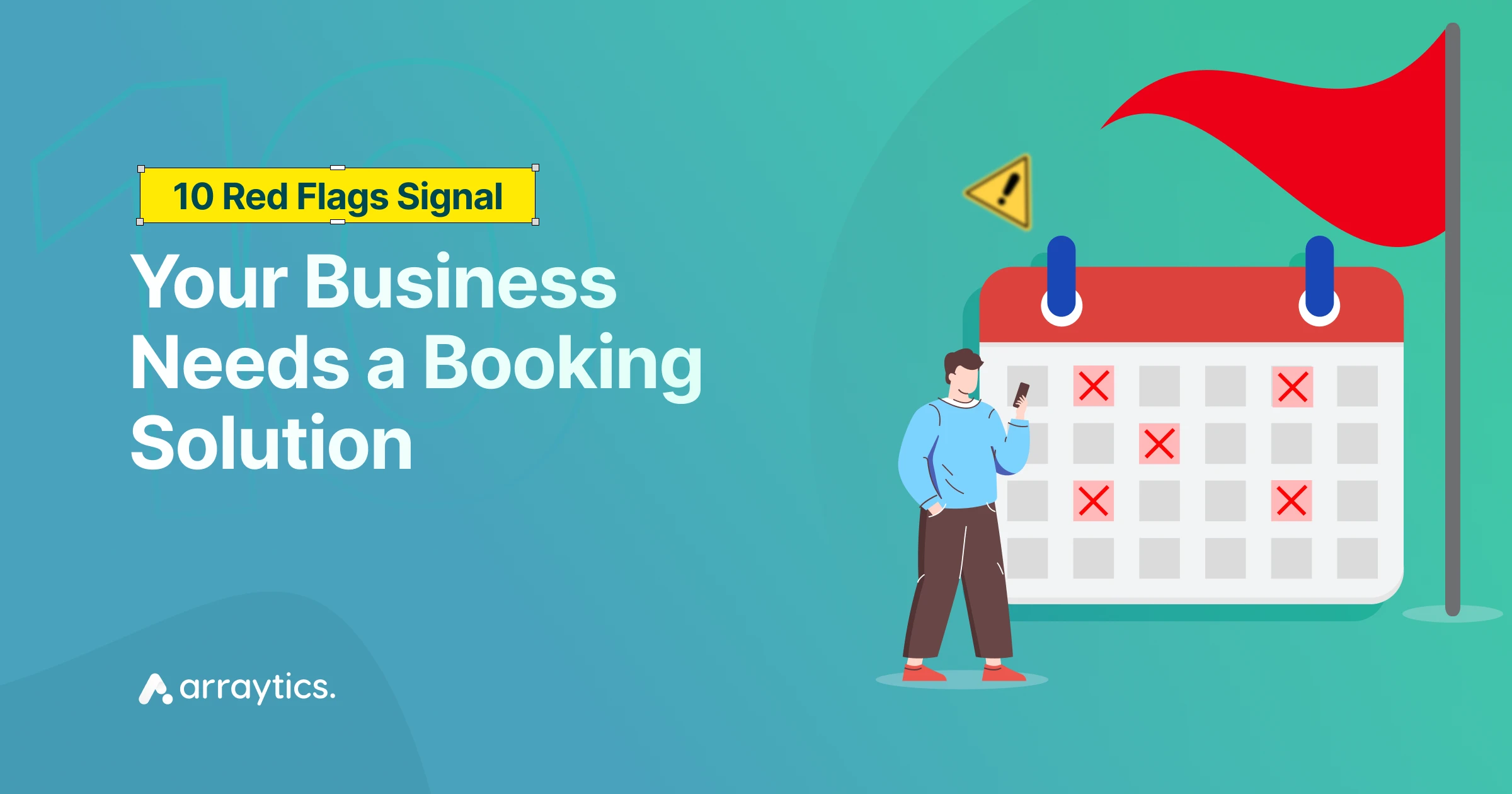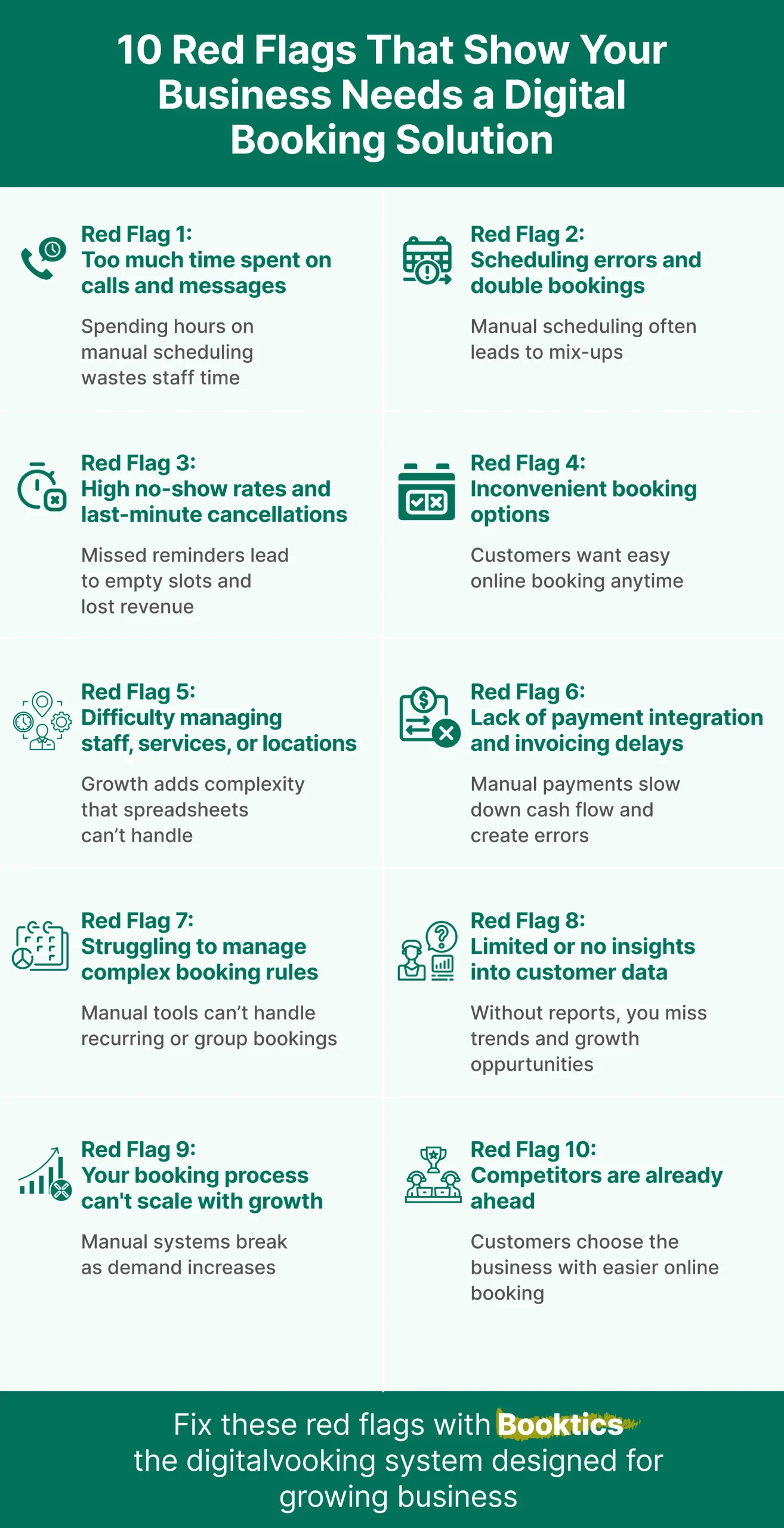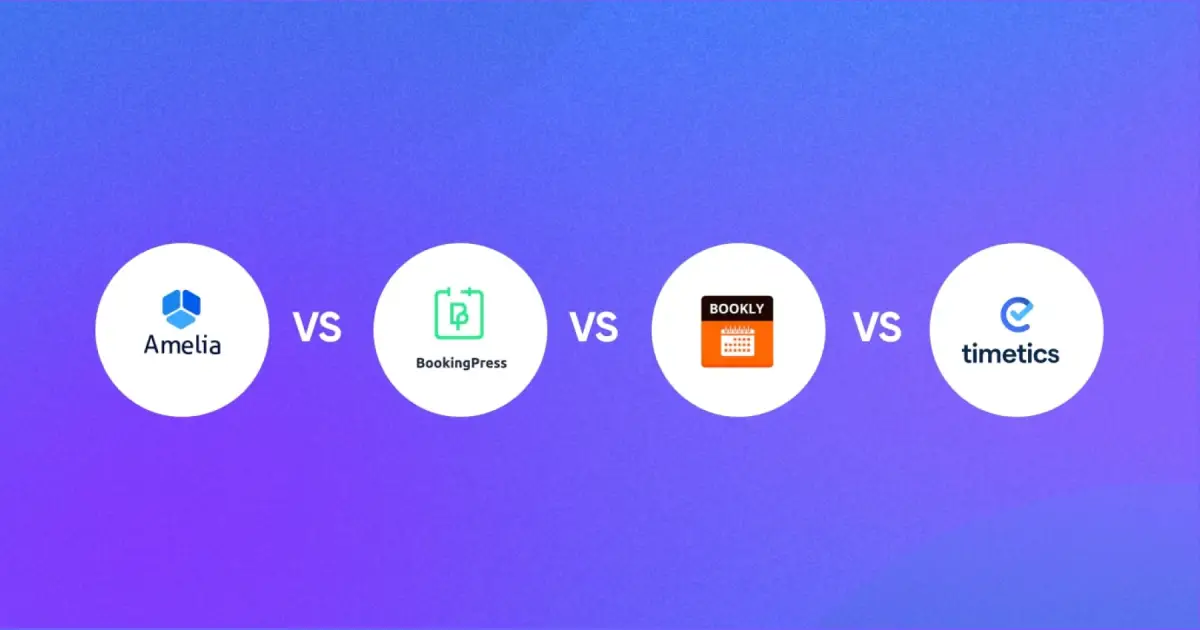10 Red Flags Your Business Needs a Digital Booking Solution (Before It’s Too Late)

Managing bookings with phone calls, emails, or spreadsheets is a good option for a small team or business. But as your customer base grows, these manual methods quickly turn into bottlenecks.
That’s why a digital booking solution becomes essential. It gives customers the freedom to book online at any time, saves hours of manual work, and keeps your business organized.
At Arraytics, we’ve worked with thousands of businesses using traditional booking methods, so we’ve seen firsthand how these hurdles slow down growth and hurt customer experience.
In this post, we’ll share 10 clear red flags that signal when your business needs a digital booking system.
If you notice even a few of these issues in your daily operations, it may be time to make the shift to an online booking system that fits your needs.
Overview: 10 red flags your business needs a digital booking solution
This guide explains what a digital booking system is, why modern businesses are moving to it, and the signals that show it is time to switch.
- What a digital booking solution is and how it replaces calls, emails, and spreadsheets.
- Why customers expect self-serve booking from any device, any time.
- Ten red flags: Time lost on calls, double bookings, no-shows, clunky payments, complex rules, no insights, scaling issues, and more.
- How to move from manual to digital in three steps: assess pain points, choose the right system, onboard staff and customers.
What is a digital booking solution?
A digital booking solution is an online system that allows customers to schedule appointments or services without needing to call or message your business. It replaces manual scheduling methods like notebooks, spreadsheets, or back-and-forth emails with an automated platform that works in real time.
Most booking systems let customers see available time slots, choose services, and confirm appointments from any device. On the business side, these tools often include features like calendar management, automated reminders, online payments, and reporting.
Whether you run a salon, clinic, fitness studio, or consulting service, an online booking system can help streamline your operations and improve the overall experience.
Why modern businesses are shifting to digital booking
Customer expectations have changed. People are used to booking services online, whether it’s ordering food, scheduling a ride, or setting up a doctor’s visit.
Now, customers no longer want to wait for business hours to call and book a service. They prefer the speedy and flexible online booking software that lets them confirm appointments anytime, from any device.
On the business side, a digital booking solution makes it easier to stay organized. It reduces human error, improves communication, and centralizes appointments, payments, and customer information in one place.
Some systems even offer insights that show which services are most popular or which time slots are often being used.
This kind of insight helps businesses operate more smoothly and respond more quickly to customer needs. It also makes it easier to scale, especially for those managing multiple staff members or locations.
💡 Read also: 10 Best WordPress Booking Plugins
10 red flags that signal you need a digital booking system

If your business is still relying on manual tools to handle appointments, you might be dealing with challenges that are easy to overlook at first but harder to ignore as you grow.
Here are ten signs that it may be time to consider a digital appointment scheduling solution.
Red Flag 1: Too much time spent on calls and messages
If your team spends a large part of the day answering calls, replying to emails, and managing booking requests manually, it’s a clear sign of inefficiency. While personal communication is valuable, repeating the same scheduling conversations over and over can quickly eat into productive time.
A digital booking solution lets customers check availability and confirm appointments on their own. This reduces back-and-forth communication and gives your team more time to focus on delivering services instead of handling repetitive tasks.
Red Flag 2: Frequent scheduling errors and double bookings
Manual scheduling often leads to mistakes, especially when multiple staff members handle appointments. It’s easy to miss details, write the wrong time, or accidentally book two clients for the same slot. These errors not only create frustration but can also damage your business reputation.
A digital scheduling solution updates availability in real time. Once a slot is booked, it’s instantly removed from the calendar, eliminating the chance of double bookings. This creates a smoother process for both you and your customers.
Red Flag 3: High no-show rates and last-minute cancellations
No-shows and last-minute cancellations cut into your revenue and disrupt your schedule. When customers don’t get reminders, it’s easy for them to forget about their appointments. Businesses that rely on phone calls or handwritten notes often have no practical way to reduce this problem.
A digital booking solution helps by sending automated reminders through email or SMS. Customers are notified in advance, which lowers missed appointments. Some systems also let you set cancellation policies or require deposits, protecting your time and income.
Reduce No-Shows and Save More Time ⏱️
Learn how an online booking system helps you cut missed appointments, automate reminders, and keep your schedule running smoothly.
Read the Full GuideRed Flag 4: Customers complain about inconvenient booking options
If your clients often mention that booking feels complicated or limited, that’s a sign your process isn’t meeting their needs. Relying only on phone calls, business hours, or in-person scheduling can frustrate customers who prefer quick, online options.
An online booking for small businesses gives customers the flexibility to book anytime, from anywhere. They don’t have to wait for your office to open or go back and forth with calls. A simple booking page improves their experience and shows that your business values convenience.
Red Flag 5: Difficulty managing staff, services, or locations
As your business grows, scheduling becomes more complex. You may need to assign staff to different shifts, handle multiple services, or coordinate across several locations. Managing all of this with spreadsheets or phone calls often leads to confusion and missed opportunities.
A digital appointment scheduling system centralizes everything in one place. You can set staff availability, link services, and manage multiple branches without juggling separate tools. This makes it easier to keep schedules organized and ensure resources are used efficiently.
💡 Read also: 10+ Pros and Cons of WordPress Booking Plugin
Red Flag 6: Lack of payment integration and invoicing delays
If your business still relies on collecting payments in person or sending manual invoices, it slows down cash flow and adds extra work for your team. Customers today expect simple and secure online payment options when they book.
A digital booking system connects payments directly to the booking process. Clients can pay at the time of booking, receive instant confirmations, and even get invoices automatically. This reduces delays, improves transparency, and makes transactions smoother for both you and your customers.
Red Flag 7: Struggling to manage complex booking rules
Not all bookings are simple one-time appointments. Some customers may need recurring sessions, group bookings, or bookings that require deposits. Handling these situations manually often creates confusion and errors.
Online booking technology makes it easier to manage these rules. You can set up recurring appointments, define booking limits, and add conditions like partial payments or deposits. This flexibility ensures you can meet different customer needs without overcomplicating your workflow.
Red Flag 8: Limited or no insights into customer data
Without a proper system, it’s hard to track practical details like your busiest hours, most popular services, or the number of returning customers. Relying on paper records or scattered spreadsheets means you miss valuable information that could help you improve your business.
A digital booking solution collects and organizes this data automatically. You can see booking patterns, customer preferences, and performance trends at a glance. These insights make it easier to plan, adjust services, and make smarter business decisions.
Red Flag 9: Your booking process can’t scale with growth
Manual booking may work when you have only a few clients, but it quickly becomes unmanageable as demand increases. More customers mean more calls, more emails, and more chances for errors. Instead of helping your business grow, your booking process becomes a barrier.
A digital appointment booking system is built to scale with your business. Whether you add new services, expand to more locations, or hire additional staff, the system can handle the increased load without extra effort. This ensures outdated booking methods don’t slow down your growth.
Red Flag 10: Competitors are already ahead
If your competitors already offer online booking and you don’t, chances are you’re losing potential customers. Today’s clients often choose the business that makes booking easiest. Even if your service is better, a complicated booking process can push people toward competitors with a digital system in place.
Adopting an appointment booking solution helps you stay competitive. It shows customers you value their time and convenience, while giving your business the same advantages that others in your industry are already using to attract and retain clients.
💡 Read also: Common Appointment Scheduling Mistakes & How to Avoid Them
How to move from manual to digital booking
Switching to a digital booking solution might seem like a big step, but it doesn’t have to be complicated. With the right approach, you can make the transition smooth for both your team and your customers.
Here’s a simple three-step process to get started.
Step 1: Evaluate your booking pain points
Before choosing a system, take a close look at what’s not working in your current process. Are you spending too much time scheduling? Are customers missing appointments or struggling to reach you? Do you have trouble tracking payments or staff availability?
Step 2: Choose a system that fits your needs and solves these problems
Not all booking systems are built the same. Some offer only basic scheduling, while others support more advanced features like payment integration, staff calendars, or customer insights.
It’s important to choose a platform that matches your business needs and addresses the specific issues you’re facing.
An online booking solution for Service-based businesses like Booktics helps solve many of the common problems that come with manual booking. It allows customers to schedule appointments online, sends automatic reminders, manages staff availability, accepts online payments, and gives you access to booking data, all in one place.
You get better control over your schedule, fewer no-shows, and a smoother experience for both your team and your customers. Check this video to know more about how to create and publish a service with Booktics.
Step 3: Onboard staff and customers gradually
Once you’ve chosen a system, give your staff time to learn how to use it. Most digital booking tools are designed to be simple, but a short training session can help your team feel more confident.
You can also introduce the new system to your customers gradually. Start by offering online booking as an option, then shift more traffic toward it over time. Make sure to share links on your website, social media, and email reminders so customers know how to use it.
💡 Read also: How to Use AI in WordPress to Automate Your Website
FAQ
Will digital booking work for small businesses?
Yes. In fact, small businesses often benefit the most from digital booking systems because they save time and reduce manual work. Even with a small team or a single location, an online booking system can help you stay organized, serve customers more efficiently, and reduce scheduling issues.
How long does a booking solution setup take?
Most modern booking systems are designed to be easy to set up. With tools like Booktics, you can typically get started in a few steps. You’ll need to add your services, set availability, and connect your calendar or payment provider if needed.
Can I sync with Google Calendar?
Yes. Many appointment booking platforms, including Booktics, offer calendar sync options. This helps you avoid double bookings and keeps your schedule updated across all your devices.
What makes Booktics different from other booking solutions?
Booktics is built to be flexible for small to mid-sized businesses. It includes essential features like service and staff scheduling, payment integration, customer reminders, and reporting — all without adding unnecessary complexity.
Can I migrate from Calendly, Acuity, or manual spreadsheets?
Yes. You can bring your booking data into a digital system. Transitioning from tools like Calendly or Acuity is straightforward, and moving away from spreadsheets means less risk of data loss and errors.
Do I need technical skills to manage Booktics?
No. Booktics is designed for business owners, not developers. The dashboard is simple, and most settings can be adjusted with just a few clicks.
💡 Read also: Best Event Management Plugin Comparison
Conclusion
If your current booking process feels inefficient, error-prone, or time-consuming, you’re not alone. Many businesses start with manual systems and only realize the limitations when those systems begin to hold them back.
An online booking platform offers a more reliable and scalable way to manage appointments, payments, and customer communication. It reduces admin work, improves customer experience, and helps you stay organized as your business grows.
If you recognized any of the red flags mentioned earlier, it might be time to take a closer look at how a tool like Booktics can help. It’s built to handle the needs of modern service-based businesses without adding complexity.
The sooner you make the shift, the sooner you can focus less on admin tasks and more on serving your customers.
Ready to simplify bookings?
Stop losing time on calls and spreadsheets. With Booktics, you can manage services, staff, and payments in one simple system.
Get started with Booktics today


